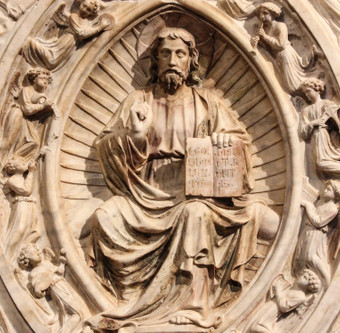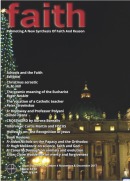
The Cosmic Meaning of the Eucharist: “The Word was made flesh and tabernacled among us.”(John 1:14)
Fr Roger Nesbitt, President of FAITH Movement
What is the place of the Eucharist in the plan of God?
The Last Supper took place the night before Jesus died on the cross. It was His last message to His disciples and to us. Two questions should be asked – What is the importance of the Eucharist in the plan of Christ? A further question arises - is there a cosmic significance to the Eucharist?
The first question is fairly easy to answer: the Eucharist is the Lord’s own final testament to the meaning of His whole life and work. From the Catechism of the Catholic Church:
“The Eucharist is the heart and the summit of the Church's life, for in it Christ associates his Church and all her members with his sacrifice of praise and thanksgiving offered once for all on the cross to his Father; by this sacrifice he pours out the graces of salvation on his Body which is the Church.” (CCC 1407)
“By the consecration the transubstantiation of the bread and wine into the Body and Blood of Christ is brought about. Under the consecrated species of bread and wine Christ himself, living and glorious, is present in a true, real and substantial manner: his Body and his Blood, with his soul and his divinity.” (CCC 1413)
Christ and Creation
On the place of Christ in creation, Scripture gives us a clear answer – that the universe was only created for Him. This is sometimes called the Scotist view of Creation:
“In the beginning was the Word: and the Word was with God, and the Word was God. He was with God in the beginning. Through him all things came to be, not one thing had its being but through him.” (John 1:1)
“He is the image of the invisible God, the first-born of all creation, for in him all things were created, in heaven and on earth: everything visible and everything invisible.” (Col 1:15)
“In the last days he has spoken to us through his Son… through whom he made everything that is.” (Hebrews 1:1-2)
“He chose us in Christ before the foundation of the world that we should be holy and blameless before him.” (Eph 1:4)
The Word made flesh
In his Encyclical Letter Mysterium Fidei Pope Paul VI, speaking of devotion to Jesus in the Eucharist outside Mass, says:
“It is not only while the sacrifice is being offered, the sacrament is constituted, that Christ is truly Emmanuel, ‘God with us’. He is so after the offering of the sacrifice, the making of the sacrament, as long as the Eucharist is kept in churches and oratories. For day by day he is in our midst, he is dwelling among us full of grace and truth (cf. John 1:14)….” (para 67)
Pope Paul VI refers to John 1:14. I would like to suggest that this important text refers not only to the Incarnation of the Son of God in Bethlehem but also to the Holy Eucharist and that it is prophetic of the Church’s development of doctrine, supporting that development, and putting it within a cosmic context.
Why “tabernacled” among us?
It is not generally realised that the second part of St John’s key statement on the Incarnation, “The Word was made flesh and dwelt (or lived) among us” should be translated literally as “tabernacled among us”.[1] This translation of eskenosen in Greek means that God “pitched his tent” among his People. This unique expression is used in the Old Testament of the “Tent of Meeting” or “Tabernacle” in the desert where Moses and Aaron went to speak with God, and which was considered the place where God lived, a constant presence among them and beside them.
The Tabernacle became the Temple
When the Israelites entered the promised land the Tabernacle, or Tent of Meeting, eventually became the Temple of God in Jerusalem, the centre of Jewish worship and liturgy. There in the Holy of Holies, God dwelt in a special way among his People. The Temple was also the place of sacrifice, and in the Holy Place were located the Bread of the Presence, the Altar of Incense, and the seven branched candlestick which showed that in the Holy Place God was the Light and Life of his People. Most probably the Sanctuary Lamp in our Catholic churches derives from this Jewish custom.
Jesus is presented as the New Temple
The words which follow in this passage, “we saw his glory” (Jn 1:14) are also related to the “overshadowing” of Mary by the Holy Spirit in the conception of Christ (Luke 1:35) and the glory of the Lord filling the “Tent of Meeting” (the Tabernacle) in the desert – “The cloud overshadowed the meeting tent and the glory of the Lord filled the tabernacle” (Exodus 40:34-35). So St John is describing the Incarnation as also the coming of Jesus the New Temple.[2]
This theme of Jesus as the New Temple, where God dwells among us, and also the Body which is sacrificed, is central to St John’s Gospel. Surely it is no coincidence that the cleansing of the Temple where Jesus says: “Destroy this Temple and in three days I will raise it up”.(John 2:19) is put at the beginning of his Gospel. John says that Jesus was referring to his own Body. We will see later that this expression also has Eucharistic connotations since John uses the word “soma” in Greek, the same word used by Jesus at the Last Supper for His Eucharistic Body.
The Eucharistic “flesh” of Jesus
Further confirmation of a Eucharistic significance of the Incarnation is also seen in John’s expression, “The Word was made flesh (sarx in Greek)”. Jesus uses the identical word recorded later in John’s Gospel for the Holy Eucharist: “The bread that I shall give is my flesh (sarx) for the life of the world.” (John 6:51), words in Greek very close to the words of consecration in the other Gospels.[3]
The Incarnation and the Eucharist – essential parts of the same plan
In this perspective on this key text (John 1:14) we have a remarkable prophetic description not only of the Incarnation but also of the Holy Eucharist and of the Tabernacle, as part of the very plan of God in sending Christ into the world.
In every Catholic church throughout the world we can see a fulfilment and a continuation through time of the Incarnation. On the altar the “Word is made flesh” at every Mass, and behind the altar, Jesus Christ is “Tabernacled among us”. The Old Temple was only in Jerusalem. The New Temple, the Living Real Presence of Jesus is now in all our churches.
Jesus in the Tabernacle at the heart of the church
Much more could be written about this beautiful theme, and of how St John, the beloved disciple of Jesus, develops it in his Gospel. Is there not here in this text, John 1:14, the nucleus of a scriptural and theological development of doctrine concerning the Reservation of Our Lord in the Blessed Sacrament? Does not the whole design of the Tabernacle in the form of a tent, and the use of the veil and the sanctuary lamp support this teaching? Must not a further consequence be that the Reservation of the “Word made Flesh”, the Lord of the cosmos and the Lord of history, can only be in the most prominent and central position in all our churches?
The Eucharist on the “altar of the world”
Pope John Paul II refers to the cosmic dimension of the Eucharist in his Encyclical Letter Eucharistia de Ecclesia (2003) para 8: “When I think of the Eucharist, and look at my life as a priest, as a Bishop and as the Successor of Peter, I naturally recall the many times and places in which I was able to celebrate it. I have been able to celebrate Holy Mass in chapels built along mountain paths, on lakeshores and seacoasts; I have celebrated it on altars built in stadiums and in city squares... This varied scenario of celebrations of the Eucharist has given me a powerful experience of its universal and, so to speak, cosmic character. Yes, cosmic! Because even when it is celebrated on the humble altar of a country church, the Eucharist is always in some way celebrated on the altar of the world. It unites heaven and earth. It embraces and permeates all creation. The Son of God became man in order to restore all creation, in one supreme act of praise, to the One who made it from nothing. He, the Eternal High Priest who by the blood of his Cross entered the eternal sanctuary, thus gives back to the Creator and Father all creation redeemed. He does so through the priestly ministry of the Church, to the glory of the Most Holy Trinity. Truly this is the mysterium fidei which is accomplished in the Eucharist: the world which came forth from the hands of God the Creator now returns to him redeemed by Christ.”
The cosmic significance of the Eucharist
The prologue of St John’s gospel already links the Incarnation to the Creation of the universe. The Bible begins with the words, “In the beginning God created the heavens and the earth” (Gen 1:1) but St John says “In the beginning was the Word” (John 1:1). Everything was created through the Word (“Logos” in Greek meaning all the Intelligence and Wisdom of God) and created for the Word to be made flesh - in Bethlehem, on the Altar and in the Tabernacle. Therefore Jesus Christ is predestined from the beginning, and is part of the very plan of God in the poising of matter at the creation of the universe, but so is the Holy Eucharist.
Confirmation of this is given in the words of Jesus recorded in St John’s Gospel chapter six, when he gives the most profound meaning of the Holy Eucharist. Our Lord, the greatest of all teachers, expounds the meaning of the Mass and of Holy Communion in a series of seven key phrases of progressively deeper meaning. Jesus says that the Holy Eucharist is:
“The bread of God which has come down from heaven”; (John 6:33)
“I am the bread of life”; (6:35)
“I am the living bread which has come down from heaven”;(6:51)
“My flesh for the life of the world”; (6:51)
“My flesh is real food and my blood is real drink”; (6:55)
The final definition, which Our Lord gives us, is that the Eucharist is simply “Me”. This is completely reflected in the teaching of the Church that in the Eucharist the bread and wine are changed by transubstantiation into Jesus Himself in Person:
“As I who am sent by the living Father myself draw life from the Father so whoever eats me will draw life from me”. (6: 57)
In this key text Jesus links the whole plan of God from the beginning to the Holy Eucharist – “As I who am sent by the living Father … so whoever eats me will draw life from me”. Jesus was sent into the world to be the Bread of Life for us. The Mass is part of the plan of God from the beginning of creation some fifteen billion years ago! The Holy Eucharist is therefore of universal and cosmic significance.
Pope John Paul II presented Jesus as “the Lord of the cosmos and Lord of history” 4 referring to this text John 1:14. Therefore this profound and prophetic text can give us a vision of the plan of God – “The Word was made flesh and tabernacled among us”. “Come let us adore him, Christ the Lord” – at Bethlehem, on the Altar and in the Tabernacle.
Notes:
Fr Roger Nesbitt
President of FAITH Movement

